This Adobong Bisaya recipe brings the authentic flavors of my childhood straight to your kitchen! After years of perfecting my grandmother's technique, I'm excited to share this treasured family recipe with you. Imagine biting into perfectly crispy pork belly that's been slowly braised in a tangy vinegar mixture until tender, then fried to golden perfection.
What makes this Visayan-style adobo special is the rich dipping sauce made from the reduced braising liquid – it's absolutely packed with flavor! This dish never fails to impress my guests and has become our family's most requested weekend meal. The contrasting textures of crispy exterior and juicy interior make this so much more exciting than traditional adobo.
What is Adobong Bisaya?
Adobong Bisaya is a regional variation of the classic Filipino adobo from the Visayas region. While most Filipino adobo dishes feature meat simmered and served in its sauce, this Visayan version takes it a step further. The pork is first braised in vinegar, water, and seasonings until tender, then fried until crispy.
The braising liquid is separately reduced into a flavorful dipping sauce. The result is a delicious contrast of textures and a more concentrated flavor experience as you dip the crispy meat into the rich sauce.
Jump to:
Why You'll Love This Recipe
- Perfect texture contrast - Enjoy the irresistible combination of crispy exterior and tender, juicy interior
- Bold flavors - The tangy vinegar marinade infused with garlic and peppercorns creates a mouthwatering flavor profile
- Make-ahead friendly - You can braise the pork ahead of time and fry just before serving
- Impressive dish - Wow your family and friends with this authentic Filipino recipe that's sure to become a favorite
- Simple technique - Despite its complex flavors, this dish uses straightforward cooking methods anyone can master
Ingredients
Each component in this recipe plays an essential role in creating authentic Adobong Bisaya flavor. Pork belly provides the perfect balance of meat and fat for juicy, crispy results.
The generous amount of garlic and whole peppercorns creates that distinctive adobo aroma, while vinegar tenderizes the meat and delivers the signature tangy flavor. Bay leaves add subtle herbal notes, and the soy sauce and brown sugar create depth in the dipping sauce without overpowering the dish.
These simple ingredients work together to create maximum flavor with minimal effort.
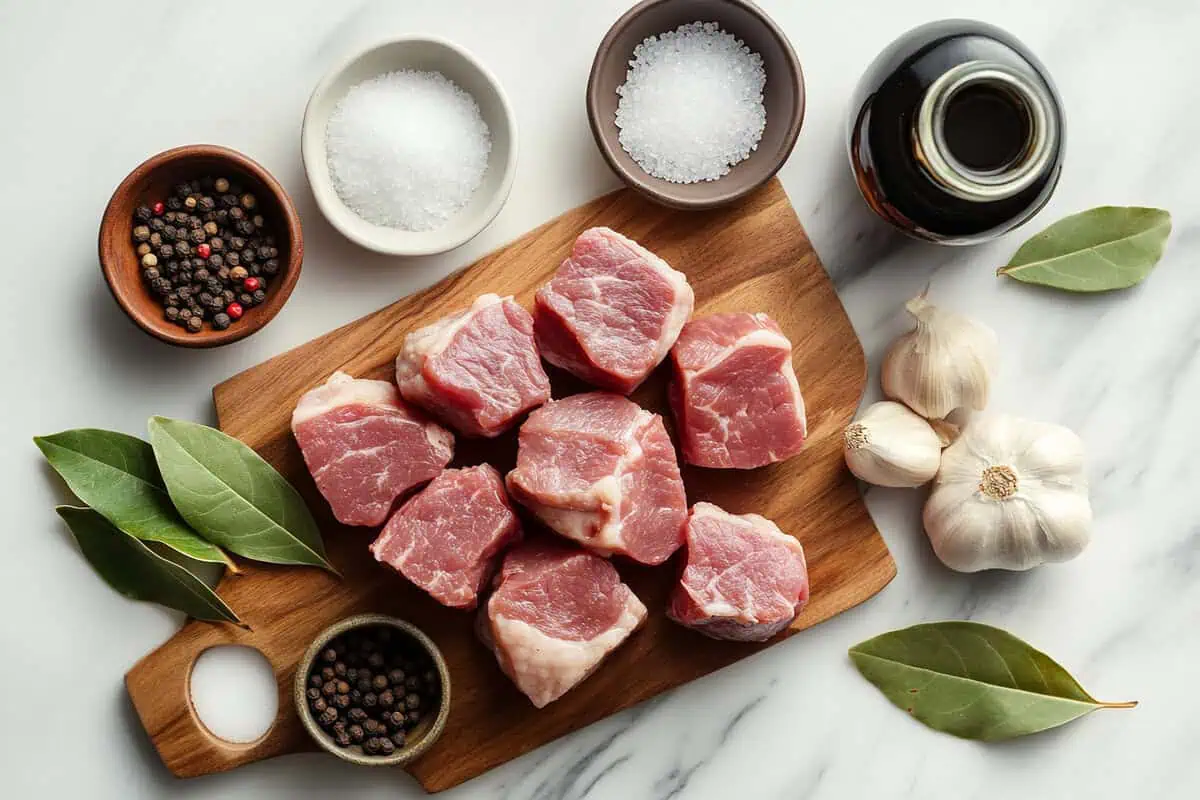
- 700g pork belly (liempo), cut into 1-inch cubes
- 2 tablespoons neutral oil, plus more for frying
- 8-12 garlic cloves, peeled and lightly smashed
- 1 tablespoon black peppercorns
- 2 cups water
- 1 cup white or coconut vinegar
- 2 tablespoons salt
- 2-3 bay leaves
- 2 tablespoons soy sauce
- 2 tablespoons brown sugar (optional)
Equipment
- Large pot or deep pan with lid for braising
- Frying pan for the crispy frying stage
- Slotted spoon for removing pork from liquid
- Paper towels for draining excess oil
- Cooking thermometer (optional but helpful for monitoring oil temperature)
- Sharp knife for cutting pork
- Measuring cups and spoons
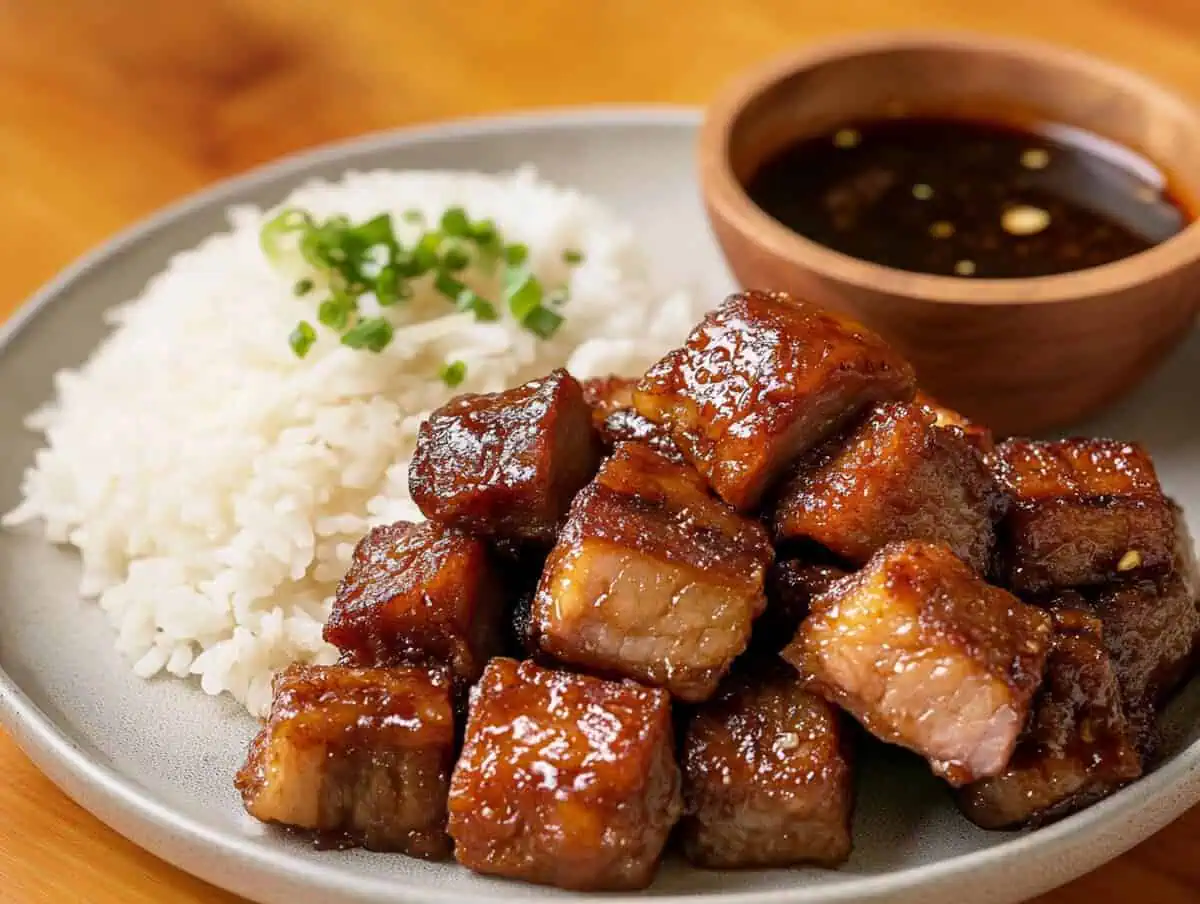
How To Make
Step 1: Braise the Pork Heat 2 tablespoons of oil in a large pot over medium-high heat. Add garlic and black peppercorns, cooking until fragrant, about 3 minutes. Add the cubed pork belly, water, vinegar, salt, and bay leaves. Bring the mixture to a boil, then reduce heat to maintain a gentle simmer. Cover the pot and cook until the pork is tender, approximately 20-30 minutes.
Step 2: Prepare the Adobo Sauce Once the pork is tender, remove it from the braising liquid and set aside. To the remaining liquid in the pot, add soy sauce and brown sugar (if using). Increase heat to medium-high and cook, stirring frequently, until the sugar dissolves and the liquid reduces by half, reaching the consistency of a thin gravy. Remove from heat and set the sauce aside.
Step 3: Fry the Pork Pour neutral oil into a frying pan to a depth of about ½-inch. Heat the oil over medium-high heat to a temperature between 350-375°F. Working in batches if necessary to avoid overcrowding, fry the braised pork until golden brown and crispy on all sides. Since the pork is already cooked, the goal is to achieve a crispy exterior without drying out the meat. This should take about 3-4 minutes total if your oil is at the proper temperature.
Transfer the fried pork to a paper towel-lined plate to drain excess oil.
Step 4: Serve Arrange the crispy fried pork on a serving plate. Serve with steamed white rice and the reduced adobo sauce on the side. Diners can either dip their pork into the sauce or drizzle it over their rice and meat according to preference.

Tips from Lola's Kitchen
- For extra crispy pork: Pat the braised pork dry with paper towels before frying. This removes excess moisture and helps achieve a crispier exterior.
- Temperature matters: Maintain your oil temperature between 350-375°F. Too hot, and the pork will burn before crisping; too cool, and the pork will absorb excess oil and become greasy.
- Season your sauce: Taste your reduced sauce before serving and adjust the salt, soy sauce, or sugar as needed to achieve your preferred balance of flavors.
- Let it rest: Allow the fried pork to rest on paper towels for 1-2 minutes before serving. This helps maintain the crispy texture.
- Don't overcrowd: Fry in batches if necessary to ensure each piece of pork has room to crisp properly.
- Save the fat: The rendered pork fat from braising can be saved and used for cooking other dishes for added flavor.
Substitutions
- Meat options: While pork belly is traditional, you can use pork shoulder, chicken thighs, or even firm tofu for a vegetarian version.
- Vinegar variations: White vinegar or coconut vinegar are traditional, but apple cider vinegar can work in a pinch. Each vinegar brings a slightly different flavor profile.
- Sugar alternatives: Brown sugar adds richness, but you can substitute palm sugar, coconut sugar, or omit it entirely for a more savory version.
- Soy sauce options: Use coconut aminos or tamari for a gluten-free version.
- Spice adjustments: Add bird's eye chilies (siling labuyo) for a spicy kick, or lemongrass for a citrusy note.
Troubleshooting
- Pork isn't tender after braising: Simply continue cooking until fork-tender. Cooking times can vary based on the specific cut and size of meat pieces.
- Sauce too thin: Continue reducing the sauce over medium heat until it reaches your desired consistency.
- Sauce too thick: Add a tablespoon of water at a time until you reach the right consistency.
- Pork not crisping: Ensure your oil is hot enough and that you've dried the pork before frying. Also, avoid overcrowding the pan.
- Too salty: Balance with a touch more sugar or a splash of water.
- Too sour: Add a bit more brown sugar to balance the acidity.
Storage & Reheating
- Storage: Keep the braised pork (before frying) and sauce separate in airtight containers in the refrigerator for up to 3 days. The fully prepared dish with fried pork is best eaten immediately but can be refrigerated for 1-2 days.
- Freezing: The braised pork (before frying) can be frozen for up to 2 months. Thaw overnight in the refrigerator before frying.
- Reheating sauce: Gently warm the sauce in a small pot over low heat until heated through.
- Reheating fried pork: For best results, reheat leftover fried pork in an air fryer at 350°F for 3-4 minutes or in a 350°F oven for 5-7 minutes until warmed through and re-crisped. Avoid microwaving as it will make the pork soggy.
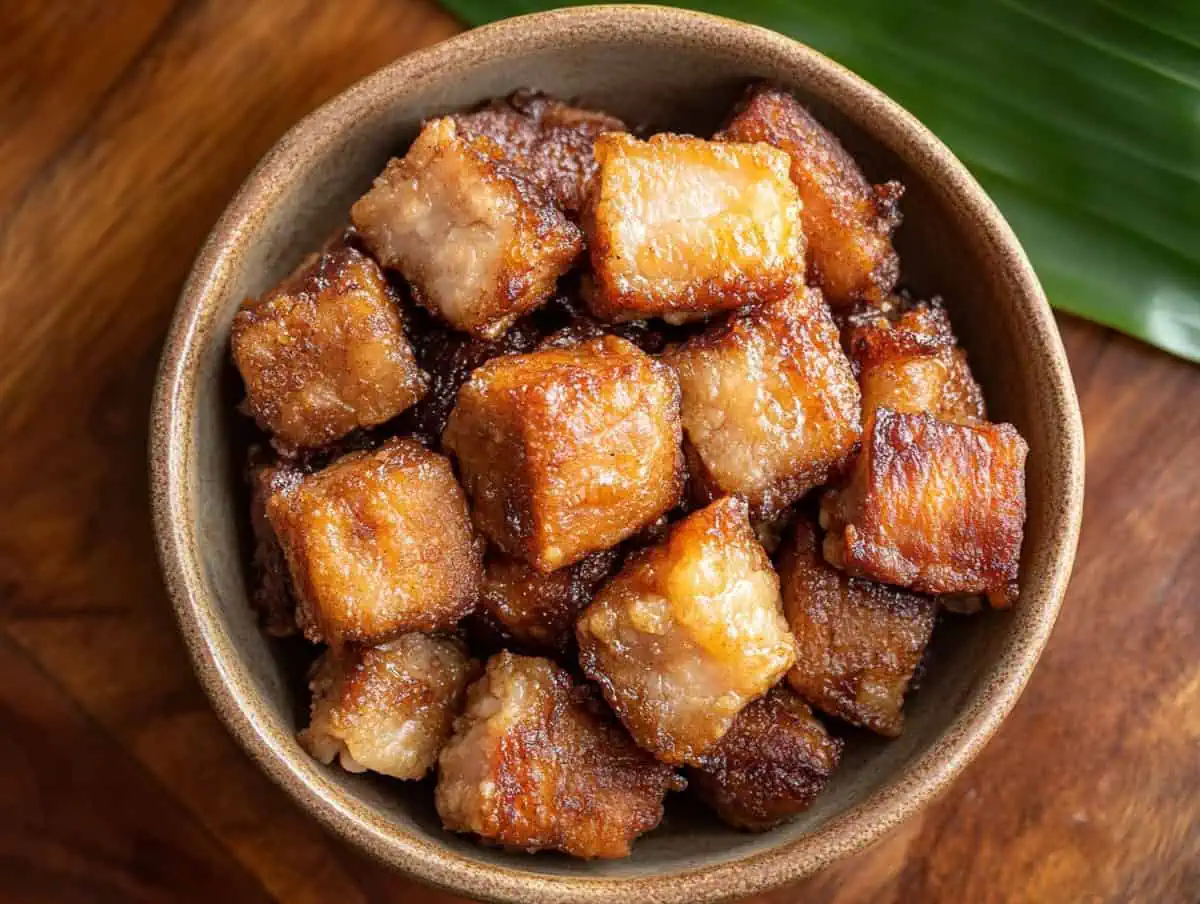
FAQ
Can I make this dish ahead of time?
Yes! You can braise the pork 1-2 days ahead and store it in the refrigerator. When ready to serve, bring the pork to room temperature, then fry it until crispy. Reheat the sauce separately.
What's the difference between regular adobo and Adobong Bisaya?
Traditional Filipino adobo keeps the meat in its sauce, while Adobong Bisaya involves an extra step of frying the meat until crispy and serving the reduced sauce on the side as a dipping sauce.
Can I use an air fryer instead of deep frying?
Absolutely! Air fry the braised pork at 400°F for 10-12 minutes, shaking the basket halfway through cooking time. While not traditional, this is a healthier alternative that still achieves a crispy exterior.
What sides go well with Adobong Bisaya?
Steamed white rice is traditional, but it also pairs beautifully with garlic fried rice (sinangag), Filipino pickled vegetables (atchara), or sautéed water spinach (kangkong).
How spicy is this dish?
Traditional Adobong Bisaya is not spicy, though it has a peppery kick from the black peppercorns. If you prefer heat, add bird's eye chilies during the braising process.
Is this recipe authentic?
This recipe captures the essence of traditional Visayan-style adobo with its characteristic vinegar braise followed by frying. Regional variations exist across the Philippines, so some families may have their own special techniques or ingredient ratios.
Can I use bone-in pork?
Yes, bone-in pork pieces work wonderfully and add extra flavor during the braising process. Just extend the braising time by about 10-15 minutes to ensure the meat is fork-tender.
What's the best vinegar to use?
Coconut vinegar (sukang niyog) is most traditional for Filipino cooking, but white vinegar produces excellent results and is more widely available.
Related
Looking for other recipes like this? Try these:
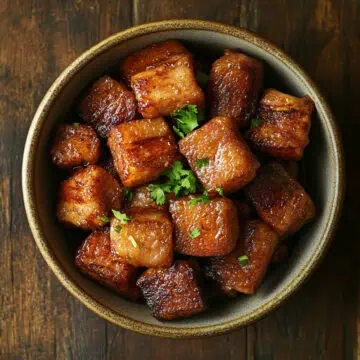
Adobong Bisaya (Visayan Crispy Fried Pork Adobo)
Ingredients
- 700 g pork belly liempo, cut into 1-inch cubes
- 2 tablespoons neutral oil plus more for frying
- 8-12 garlic cloves peeled and lightly smashed
- 1 tablespoon black peppercorns
- 2 cups water
- 1 cup white or coconut vinegar
- 2 tablespoons salt
- 2-3 bay leaves
- 2 tablespoons soy sauce
- 2 tablespoons brown sugar optional
Instructions
Step 1: Braise the Pork
- Heat 2 tablespoons of oil in a large pot over medium-high heat. Add garlic and black peppercorns, cooking until fragrant, about 3 minutes. Add the cubed pork belly, water, vinegar, salt, and bay leaves. Bring the mixture to a boil, then reduce heat to maintain a gentle simmer. Cover the pot and cook until the pork is tender, approximately 20-30 minutes.
Step 2: Prepare the Adobo Sauce
- Once the pork is tender, remove it from the braising liquid and set aside. To the remaining liquid in the pot, add soy sauce and brown sugar (if using). Increase heat to medium-high and cook, stirring frequently, until the sugar dissolves and the liquid reduces by half, reaching the consistency of a thin gravy. Remove from heat and set the sauce aside.
Step 3: Fry the Pork
- Pour neutral oil into a frying pan to a depth of about ½-inch. Heat the oil over medium-high heat to a temperature between 350-375°F. Working in batches if necessary to avoid overcrowding, fry the braised pork until golden brown and crispy on all sides. Since the pork is already cooked, the goal is to achieve a crispy exterior without drying out the meat. This should take about 3-4 minutes total if your oil is at the proper temperature.
- Transfer the fried pork to a paper towel-lined plate to drain excess oil.
Step 4: Serve
- Arrange the crispy fried pork on a serving plate. Serve with steamed white rice and the reduced adobo sauce on the side. Diners can either dip their pork into the sauce or drizzle it over their rice and meat according to preference.
Tips from Lola's Kitchen
- For extra crispy pork: Pat the braised pork dry with paper towels before frying. This removes excess moisture and helps achieve a crispier exterior.
- Temperature matters: Maintain your oil temperature between 350-375°F. Too hot, and the pork will burn before crisping; too cool, and the pork will absorb excess oil and become greasy.
- Season your sauce: Taste your reduced sauce before serving and adjust the salt, soy sauce, or sugar as needed to achieve your preferred balance of flavors.
- Let it rest: Allow the fried pork to rest on paper towels for 1-2 minutes before serving. This helps maintain the crispy texture.
- Don't overcrowd: Fry in batches if necessary to ensure each piece of pork has room to crisp properly.
- Save the fat: The rendered pork fat from braising can be saved and used for cooking other dishes for added flavor.
The Story Behind Adobong Bisaya
Filipino adobo has countless regional variations across the 7,000+ islands of the Philippines, but Adobong Bisaya stands out with its distinct preparation method that showcases the ingenuity of Visayan cooking traditions. Originating from the central Visayas region, this crispy pork adobo variant tells a story of Filipino resourcefulness and culinary adaptation.
In traditional Filipino households, especially in rural Visayan provinces like Cebu, Bohol, and Negros, cooking techniques were often developed to extend the shelf life of dishes in tropical weather before refrigeration was widely available. The vinegar-based braising method of adobo already served as a preservation technique, but the additional step of frying the meat until crispy further removed moisture—the enemy of food preservation—while creating an irresistible texture contrast.
Many Filipino food historians believe Adobong Bisaya evolved from practical necessity. In the hot, humid climate of the Visayas, leftover traditional adobo might spoil quickly if left sitting in its sauce. By removing the meat and frying it crisp, then reducing the sauce separately, families could enjoy their adobo for longer periods while transforming leftovers into something that felt like a completely new dish.
What's fascinating about Filipino cuisine is how regional differences reveal cultural influences. While the Spanish introduced the term "adobo" (meaning marinade or seasoning mix), the cooking method itself has pre-colonial origins. The Visayan take on adobo demonstrates the region's preference for bold flavors and distinct textures, which can be seen across other Visayan specialties like lechon Cebu and humba.
In many Visayan homes, this dish isn't always called "Adobong Bisaya"—it might simply be referred to as "piniritong adobo" (fried adobo) or "nagmamantikang adobo" (adobo with rendered fat). The technique of transforming braised meat by frying it until crisp appears in other beloved Filipino dishes like Bistek Tagalog and pork sisig, showing how deeply ingrained this cooking approach is across Philippine culinary traditions.
Today, Adobong Bisaya has gained popularity beyond the Visayas, appearing on restaurant menus and family tables throughout the Philippines and in Filipino communities worldwide. Its appeal lies in how it honors tradition while creating something uniquely delicious through simple technique rather than complicated ingredients. Each bite of crispy, tangy pork dipped in rich reduced sauce connects diners to generations of Filipino home cooks who transformed necessity into culinary artistry.
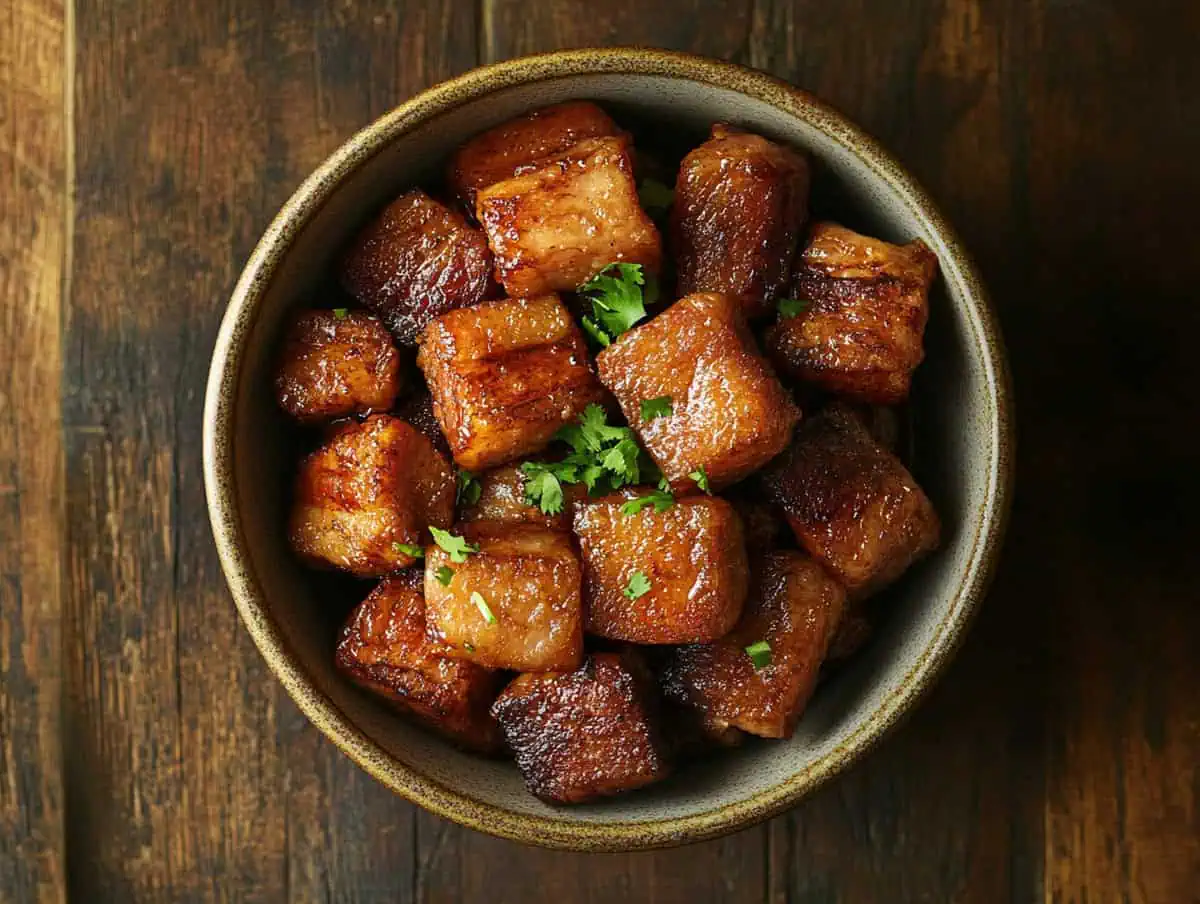








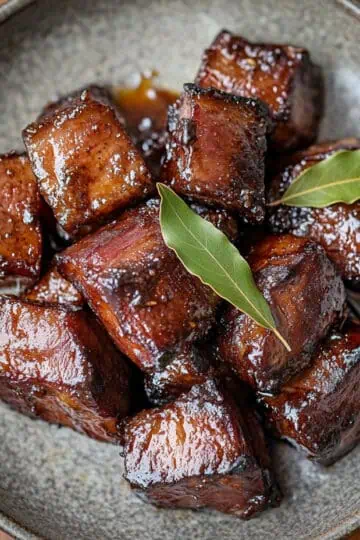
Comments
No Comments